The X Button
Into the Blue
by Todd Ciolek,

I've noticed a trend: Square Enix promises to unveil a secret game, and then a website or magazine ruins the surprise immediately after I mention the supposedly unknown game in this column. Sigh.
Well, the latest such title, teased by this website last week, is Matrix Software's Four Warriors of Light: Final Fantasy Gaiden. A turned-based RPG that sticks to the conventions of the earliest Final Fantasies, it casts the lead as a hero who, get this, sets out to rescue a princess. Of course, it looks much like Matrix's DS remakes of Final Fantasy III and IV, with squat polygon characters and detailed surroundings. The game's heavy on the customization, with each piece of equipment changing your character's look, and there's even a four-player feature.
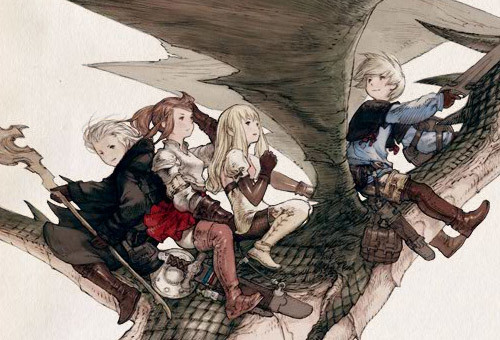
The character art comes from Akihiko Yoshida of Vagrant Story, Final Fantasy XII, and Final Fantasy Tactics. I've always liked his work, despite his confessed fixation with characters' rear ends.
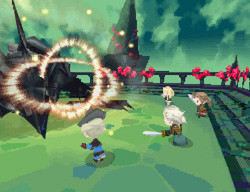
Devoted Final Fantasy enthusiasts will remind us all that the “Final Fantasy Gaiden” subtitle goes back to the original Seiken Densetsu, known as Final Fantasy Adventure in the West. Yes, many people will tell you this, but I'm actually going to show off the ad for the game.
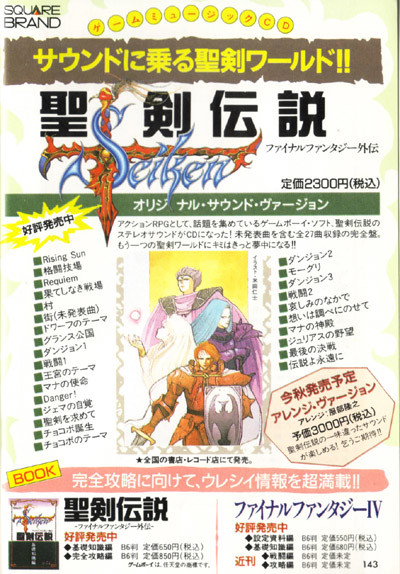
There it is on the right: Final Fantasy Gaiden.
NEWS
XSEED LANDS SKY CRAWLERS: INNOCENT ACES
 Mamoru Oshii's The Sky Crawlers might never be the box-office fireball that its director perhaps jokingly hoped for, but at least it has its own Wii game. And we're getting it in North America late this year, thanks to XSEED Games. A flight simulator played with the Wii remote and nunchuck seems an idea fraught with problems, but Namco Bandai put the developers of the Ace Combat series to work on The Sky Crawlers: Innocent Aces.
The huge-scale dogfights of the film might have been intentionally shallow and confusing, but the Ace Combat team knows how to make a coherent flight simulator.
Mamoru Oshii's The Sky Crawlers might never be the box-office fireball that its director perhaps jokingly hoped for, but at least it has its own Wii game. And we're getting it in North America late this year, thanks to XSEED Games. A flight simulator played with the Wii remote and nunchuck seems an idea fraught with problems, but Namco Bandai put the developers of the Ace Combat series to work on The Sky Crawlers: Innocent Aces.
The huge-scale dogfights of the film might have been intentionally shallow and confusing, but the Ace Combat team knows how to make a coherent flight simulator.
The game features another round of young pilots forced to fly in a meaningless war, and some of them look similar to the film's characters. If you've seen the movie, you know why that's important. The Sky Crawlers might be my favorite major anime film of the last five years, so I'm excited about the idea of a related game that doesn't suck. Hey, it made Mamoru Oshii smile, and that must count for something.
SAKURA WARS V SHIPS ON TWO DISCS FOR NORTH AMERICA
Some were wondering just how NIS America would localize Sakura Wars: So Long, My Love for its North American release this winter. The game has copious voice acting, so it would be a challenge to cram both English and Japanese tracks on one disc. NISA's solution? Sakura Wars: So Long, My Love will ship on two discs: one will be the entire game with English voices, the other will feature it with subtitled Japanese dialogue. The text will be the same in both versions, and I hope that game saves will be compatible with either disc. Either way, the two-disc set will run $39.99 for the PlayStation 2 and the Wii.
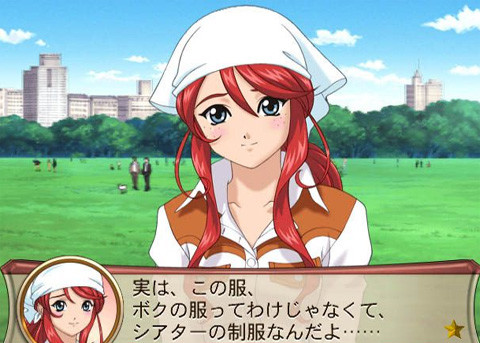
Oh yeah, about the title: it's technically Sakura Wars V, but this is the first Sakura Wars game to be released in these barbaric Western nations. NISA apparently doesn't want impulse buyers shunning this Sakura Wars just because they haven't played the first four.
RUNE FACTORY 3 ANNOUNCED
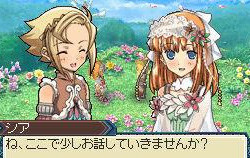 The Rune Factory series now seems to have a life of its own, separate from the Harvest Moon franchise that sired it. Each Rune Factory still has the farming and spouse-finding gameplay that Harvest Moon boasted, but it's also full of fantasy-RPG elements. Rune Factory 3, newly announced for the DS in Japan, adds another such feature by letting its main character change into monsters, sorta like Rue did in Threads of Fate.
The Rune Factory series now seems to have a life of its own, separate from the Harvest Moon franchise that sired it. Each Rune Factory still has the farming and spouse-finding gameplay that Harvest Moon boasted, but it's also full of fantasy-RPG elements. Rune Factory 3, newly announced for the DS in Japan, adds another such feature by letting its main character change into monsters, sorta like Rue did in Threads of Fate.
More interesting is the fact that the main character, Mais/Meis/Mice, can converse with townsfolk and major characters while you're a creature. It's a neat idea, though I wonder how it'll affect the game's dating element; perhaps, like Zeus in Greek myths, our hero will win over women by appearing to them as a swan or something. Rune Factory 3 is developed by Neverland Company (the first three Lufia games), and it'll be out in Japan by the end of the year.
IN BRIEF: SHADOW OF DESTINY ON PSP, TEKKEN 6 SHUNS LOCKS, DRAGON BALL SEWN UP BY NAMCO-BANDAI
I really thought Konami had forgotten about Junko Kawano's Shadow of Destiny. It was one of the first truly intriguing PlayStation 2 games (along with Ring of Red, also from Konami), and its story's branching, Faust-inspired approach to time travel made it a tale worth revisiting. Shadow of Destiny is mentioned little nowadays, but Konami's decided to port it to the PSP in Japan, where the game's known as Shadow of Memories. A U.S. release isn't likely, though maybe Kawano's Time Hollow sold better on the DS than I suspect it did.
Tekken 6 director Katsuhiro Harada has stated that all of the game's 40 characters will be available immediately in its home ports, with no pesky unlocking. It's a move foreshadowed by Soul Calibur IV, in which releasing most of the extra cast members took about 45 minutes. A shame Street Fighter IV didn't have the same feature.
If you're looking for upcoming Dragon Ball games to wash away the taste of the recent live-action film, you'll find those games coming from Namco Bandai. The publisher recently announced the rights to release Dragon Ball properties in North America. This comes after Atari, which brought out several Dragon Ball Z fighters, fell into a legal squabble with FUNimation. With its new dominance of the property, Namco Bandai plans three releases this year: the action game Dragon Ball: Revenge of King Piccolo for the Wii, the RPG-like Dragon Ball Z: Attack of the Saiyans for the DS, and the fighter Dragon Ball: Raging Blast for the Xbox 360 and PlayStation 3.
REVIEW: BLAZBLUE
 Developer: Arc System Works
Developer: Arc System Works
Publisher: Aksys Games
Platform: Xbox 360/PlayStation 3
Players: 1-2 (online)
MSRP: $59.99
You must forgive me if I can't stop comparing BlazBlue to Guilty Gear, that fighting-game blend of rock excess and anime stylings that has profited Arc System Works for over 10 years. BlazBlue is technically an entirely separate game, with a completely original cast of characters and some novel gameplay ideas, yet it lies within Guilty Gear's territory of quick, dizzyingly bright battles and bizarre warriors bouncing, flashing, and tearing across the screen. BlazBlue doesn't always improve on what came before, but it's still the most impressive new fighter we've seen in a long time.
The stage for BlazBlue is a typical futuristic society where, in the course of destroying a world-threatening creature known as The Beast (subtle!), six heroes brought about a magical power called Armagus. In subsequent years, that power gave rise to an organization called the Novis Orbis Librarium, which lifted civilization to new heights while brutally putting down rebellions. More complicated details fly during the game's story mode, but it burns down to soldiers, cyborgs, ninja, vampires, catgirls, and bounty hunters smacking each other around the city of Kagutsuchi.
If the cast is a collection of fighting-game archetypes, Blazblue's game engine offers something a bit more creative than usual: the Drive Attack. Overhauling the original Guilty Gear's setup, BlazBlue gives each character three basic striking buttons plus a Drive key that varies wildly in its effects with each character. White-haired, heterochromatically eyed swordsman Ragna the Bloodedge uses his Drive for life-stealing attacks and a power-up move stolen from Guilty Gear lead Sol Badguy, but the rest of the cast proves much more inventive. Jin Kisaragi, Ragna's Ky-like rival, freezes his foes for convenient combo setups. The snobbish gothic vampire Rachel Alucard (yes, it's the Dracula-backwards gag, already worn weary by other games and anime) controls the wind, pushing around both herself and enemy attacks. Kid magician Carl Clover has a mechanical sidekick, creepily referred to as his sister, that joins his attack when the Drive button is held down. Library officer Noel Vermillion and her twin pistols spark all sorts of combo attacks when her Drive move is in play. Future-Chinese doctor Litchi Faye-Ling uses a staff, jumping off of it and changing her attacks when it's not in her hands. Still, they're all outdone by delusional superhero-ninja Bang Shishigami, whose fully powered Drive gives him glowing agility and an in-game theme song by Hironobu Kageyama.
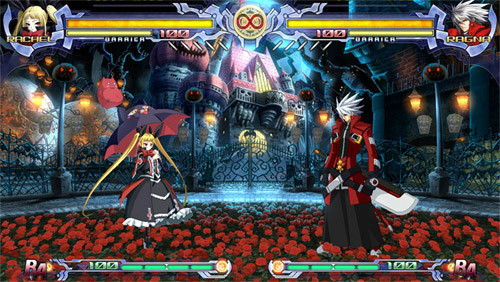
Guilty Gear prided itself on odd characters, and BlazBlue goes even further. No two of them are remotely alike, and outside of the expected Ken-Ryu duo of Ragna and Jin, it's hard to pick out any play styles seen in previous fighting games. Beyond the Drive attacks, BlazBlue is in the Guilty Gear school, offering speedy fights that allow plenty of dodging and specialized blocking, including both a shield and an “instant block” system that some may recognize from Fatal Fury: Mark of the Wolves. The Barrier Burst is a clever little addition, as it lets a player avoid an attack while lowering his or her defense (and putting “danger” in the life bar) for the rest of a round. BlazBlue also plays heavily on aerial maneuvers. You can dash, block, recover, and double-jump while you're off the ground, and Iron Tager, the ogre-like heavyweight of the bunch, is the only character without mid-air special moves.
BlazBlue's sturdy, smooth play mechanics serve it well, but it's the depth of fighting styles that's truly worthwhile. Despite the mix of characters, nearly all of them are fun, and learning their varied strengths and idiosyncrasies is enjoyable even without other players in the mix. There's a good balance at work in two-player duels, with the less approachable characters proving slightly more effective than the more familiar ones. I have no doubt that the competitive fighting-game fan base will discover cheap maneuvers and regiment the cast into strict layers (online play already seems to be heavy on the Noels), but such is their prerogative.
In the ongoing battle to see which fighting game can look the sharpest, BlazBlue delivers large, vibrant characters that move much more smoothly than the pretty-but-stiff combatants of Guilty Gear. The backgrounds show off all sorts of impressive 3-D architecture, dotted with little details like waving flowers and scampering cat-children. The soundtrack is furious pop-metal cheese from Guilty Gear creator Daisuke Ishiwatari, who turns in all sorts of clashing riffs and orchestral atmosphere (even if he borrows openly from his Guilty Gear soundtracks). BlazBlue's also notable for its extensive voice acting. It's in both Japanese and fairly well-acted English, and a character's voice clips frequently change depending on the opponent. Ragna and Rachel throw personal barbs as they belt each other around, while Noel will shriek “Hands off the panda!” when performing her Optic Barrel gunshot against Litchi and her hair-dwelling bear.
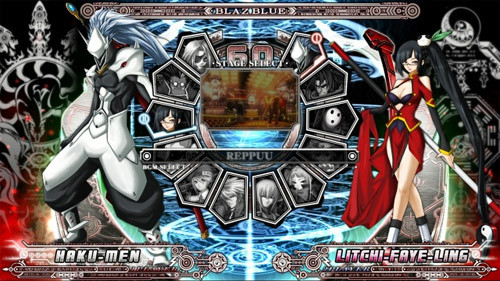
For those who love the elaborate plots and characters of the Guilty Gear games, BlazBlue might have the most extensive story mode of any fighter around. Each main cast member gets an arc with multiple paths, simplified fights, and lots and lots of talking. Occasionally resembling a visual novel in its text, BlazBlue's multiple storylines lead characters through Kagutsuchi and, unfortunately, none gets terribly interesting. Guilty Gear's stories were often mere confrontations, yet the games still had a cast of likeable misfits to run across and over each other. BlazBlue's more generic lineup doesn't have the same chaotic appeal, and their tales are overlong and overwrought. Witness Ragna's background, which involves a burning church and a sickly little sister and a disturbed little brother. The translation is generally decent, but it's overridden by dull storytelling.
It's unfortunate that Guilty Gear fans, the ones most easily drawn to BlazBlue, are also the ones most likely to be let down by the game's comparatively bland plot and designs. In looks and backstory, most of the characters resemble Guilty Gear fighters; the bloblike Arakune is a melting Eddie, Litchi is Jam, Hakumen looks a lot like Justice, and leading man Ragna is Sol Badguy with raw, undiluted angst instead of gruff disdain. No, fighting games don't need stories, but memorable characters always help, and BlazBlue has too many faces that the average fighter enthusiast or anime fan has seen many times already.
The characters who aren't cast in solid stereotypes are often less appealing. Jin Kisaragi is clearly not Guilty Gear's Ky Kiske, because Ky was amusingly over-earnest and sympathetic. Jin is a sneering jackass who occasionally dips into raving psychosis, and he's never interesting for it. Noel is also a disgrace. She's one of the game's three key characters, along with Ragna and Jin, and her role suggests a sensible, dedicated counterpoint to both Ragna's gloom and Jin's unstable cruelty. Yet she's the exact opposite. While apparently a soldier, she seems a timid, perpetually ashamed, kitten-like schoolgirl who spends her story mode in a ringer of breast jokes and forced costume changes.
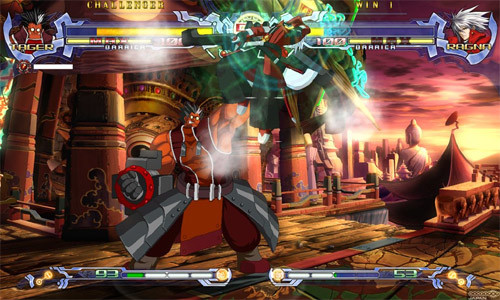
Some of the other fighters come off better. Rachel is entertaining in her regal condescension, and her attacks and demonic sidekicks make her look like some unused fighter from the Darkstalkers series. Bang is an endearing goofball, and it takes awhile for his glorious theme song to get old. Taokaka's look is creative for an anime catgirl, even if her personality can grate. And they're the highlights. All too often, BlazBlue resembles Guilty Gear with its hair-metal overkill removed and replaced by standard anime science fiction.
Aksys Games put together an impressive limited edition for BlazBlue's first run, packing in a two-disc soundtrack and a DVD of instructive clips that should explain some of the game's stranger gameplay points. The online modes are also extensive, with lobbies and helpful ways for finding opponents suitable to your skill level. It's quite refreshing after the limited versus-mode interfaces of Street Fighter IV and numerous Xbox Live Arcade ports.
BlazBlue lacks the engaging atmosphere of other major fighting games, but it has everything it could need in terms of satisfying structure. Yes, the rather wordy storyline doesn't go anywhere. Yes, the characters are rarely striking. Yes, I hate Noel's story and all that it represents. There's still a rewarding breath of competitive, carefully honed game design, and that's truly what decides a fighter's success. Even though BlazBlue might not spawn a hugely successful franchise to match The King of Fighters or Guilty Gear, it certainly deserves that bright of a future.
RELEASES FOR THE WEEK OF 7-12
HOLY INVASION OF PRIVACY, BADMAN! The full title of this PSP dungeon-maker is Holy Invasion of Privacy, Badman! What Did I Ever Do to Deserve This?, and, unlike last week's Violence Jack game, I can assure you that this one is not a joke. It's a very real and very inventive twist on the you're-the-villain trend that's slunk around the industry through games like Overlord and Disgaea. You play as not the prime antagonist, but rather the dungeon designer for a laid-back, conquer-it-as-it-comes kind of evil mastermind. He sits in his underground lair while you build it around him and take out the heroes who come to end his reign of easygoing terror. Your dungeons are dug out one square screen-tile at a time, and you can infest them with all sorts of traps and monsters, gradually building a food-chain of beasts to create fearsome bosses. It's a great idea for a game, and I urge reconsideration for those of you who refuse to buy the game just because it's a download-only title without even the box that Patapon 2 had. Really, it's one of the most creative new games to come out for the PSP this year, and $20 isn't too bad for a game that you can't own on UMD. You can save your outrage for CAPCOM's upcoming download-only $30 release of Fate/Unlimited Codes. |
EXTRA LIVES: SAMURAI PIZZA CATS
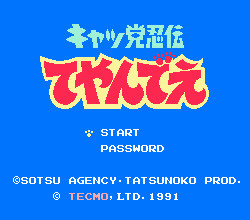 Samurai Pizza Cats holds a special place among anime series diced, dubbed, and served to Americans in the 1990s. Saban Entertainment mercilessly rewrote and edited the original show to make it a complete parody of cutesy Japanese superhero cartoons, and, unlike Sailor Moon or Dragon Ball Z, no one really cared about the changes. Most fans seem to prefer the Americanized quips of Samurai Pizza Cats, and a lot of them roll their eyes when they're reminded that the show was originally called Kyattou Ninden Teyandee. So was the Famicom game that it inspired, but this surprisingly fun platformer never became a Samurai Pizza Cats title for North American fans.
Samurai Pizza Cats holds a special place among anime series diced, dubbed, and served to Americans in the 1990s. Saban Entertainment mercilessly rewrote and edited the original show to make it a complete parody of cutesy Japanese superhero cartoons, and, unlike Sailor Moon or Dragon Ball Z, no one really cared about the changes. Most fans seem to prefer the Americanized quips of Samurai Pizza Cats, and a lot of them roll their eyes when they're reminded that the show was originally called Kyattou Ninden Teyandee. So was the Famicom game that it inspired, but this surprisingly fun platformer never became a Samurai Pizza Cats title for North American fans.
Kyatto Ninden Teyandee arrived on the Famicom in 1991 courtesy of Tecmo, a company by then known in the West for Ninja Gaiden, Solomon's Key, Rygar, and a few other NES games that had little to do with anime. Tecmo easily made Teyandee into a side-scroller offering control of all three samurai-cat leads: Yattaro (a.k.a. Speedy Cerviche), Pururun (Polly Esther), and Sukashii (Guido Anchovy). The three of them share similar up-close attacks and ninja-star projectiles despite their different weapons, though they grow different after upgrading their special attacks to two further levels.
 While the player can pick only one of the three cats at the start of each level, this chosen hero can switch places with one of the four support-team members at any time. Each of them has a different special skill: Mietoru can fly, Gotton can drill through conveniently placed sections of earth, Nekkii can swim better than the others, and Rikinoshin can break huge boulders. There's no penalty for switching between team members, but everyone shares the same life meter, along with a special-attack power gauge and a speed indicator that depletes with certain moves.
While the player can pick only one of the three cats at the start of each level, this chosen hero can switch places with one of the four support-team members at any time. Each of them has a different special skill: Mietoru can fly, Gotton can drill through conveniently placed sections of earth, Nekkii can swim better than the others, and Rikinoshin can break huge boulders. There's no penalty for switching between team members, but everyone shares the same life meter, along with a special-attack power gauge and a speed indicator that depletes with certain moves.
Tecmo's Ninja Gaiden series includes some of the best action-platformers on the NES or Famicom, and it was clearly the groundwork for Teyandee. Though the pace is never as fast and the enemies are never as brutal, Teyandee shares many of Ninja's Gaiden's control options, down to the Castlevania-derived use of special attacks. The game is looser than Ninja Gaiden, but it's surprisingly well-constructed for something built from an anime license. The enemies are quick but rarely unfair, the control is responsive, and the large lineup of characters keeps any level from getting too dull.
 In their fight against a corrupt fox-minister (who became a rat and was re-named Seymour Cheese in Samurai Pizza Cats), the felines traverse a conventional set of stages, from sewers to floating fortresses to moored ships to maze-like carnival houses. The level design borrows from both Ninja Gaiden and Mega Man, setting up generic challenges (conveyor belts) and strange ones (mid-air blobs that characters can swim through). For an NES-era action game, it offers a good amount of freedom; the middle batch of stages can be finished in any order, and there's often more than one route through them.
In their fight against a corrupt fox-minister (who became a rat and was re-named Seymour Cheese in Samurai Pizza Cats), the felines traverse a conventional set of stages, from sewers to floating fortresses to moored ships to maze-like carnival houses. The level design borrows from both Ninja Gaiden and Mega Man, setting up generic challenges (conveyor belts) and strange ones (mid-air blobs that characters can swim through). For an NES-era action game, it offers a good amount of freedom; the middle batch of stages can be finished in any order, and there's often more than one route through them.
Tecmo's Teyandee is perhaps a little too easy, though that might be a blessing to any anime fan who's sat through the rigidly challenging licensed titles of the Famicom's first generation. Aimed at the young Teyandee fans, the game proves fairly long at 11 stages and gets difficult only at its final leg. The only nagging point stems from its Mega Man influence, which shows in the way none of the characters can duck.
 There were sharper-looking games for the NES and Famicom in 1991, but Teyandee remains fairly impressive. The backgrounds and character animation work nicely, and the sheer variety of goofball enemies, including guitar-playing jellyfish, shows some dedication. The game also imitates its source thoroughly, with plenty of brightly colored story scenes featuring just about every hero and villain from the TV show. The game also adds the avian Dr. Purple, a mad scientist with a Dr. Wily-level collection of mechanized creatures (as far as I can tell, he never showed up in the TV series). There's also a humming title-screen take on the show's theme music (the Japanese one, that is), and the rest of the soundtrack is, at best, inoffensive.
There were sharper-looking games for the NES and Famicom in 1991, but Teyandee remains fairly impressive. The backgrounds and character animation work nicely, and the sheer variety of goofball enemies, including guitar-playing jellyfish, shows some dedication. The game also imitates its source thoroughly, with plenty of brightly colored story scenes featuring just about every hero and villain from the TV show. The game also adds the avian Dr. Purple, a mad scientist with a Dr. Wily-level collection of mechanized creatures (as far as I can tell, he never showed up in the TV series). There's also a humming title-screen take on the show's theme music (the Japanese one, that is), and the rest of the soundtrack is, at best, inoffensive.
Saban had Samurai Pizza Cats on the air by 1991, but it wouldn't pull over the Famicom game. While the show itself was a syndicated cult success, Tecmo didn't want to put out a Samurai Pizza Cats game on the NES when the Super NES was just around the corner. It's a shame, since this capable little platformer is far better than the usual anime-inspired dross, and its style would have played right into the self-mocking humor that won over so many Samurai Pizza Cats fans.
I couldn't turn up copies of Kyatto Ninden Teyandee through the usual venues, which means that it's either really rare or that Samurai Pizza Cats fans have hunted it to extinction. If you try to play it through emulation, you'll find a translated version that, sadly, doesn't use the Samurai Pizza Cats names.
discuss this in the forum (37 posts) |
this article has been modified since it was originally posted; see change history
 Developer:
Developer: